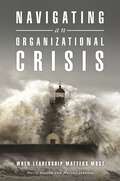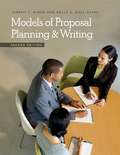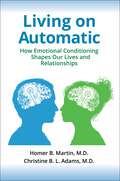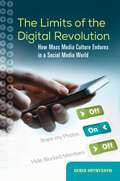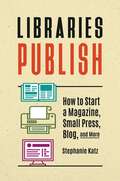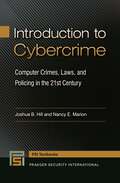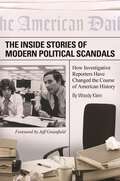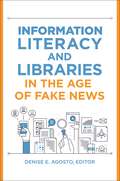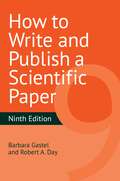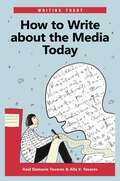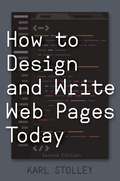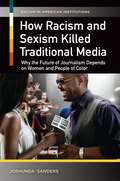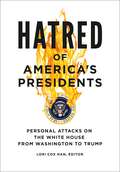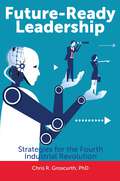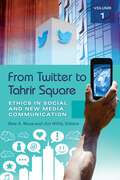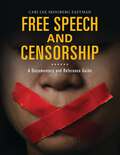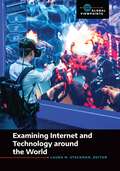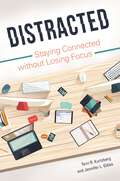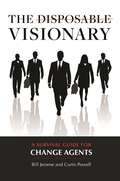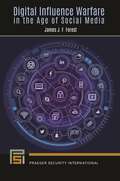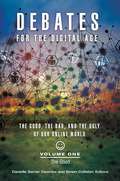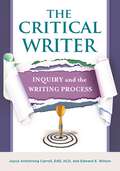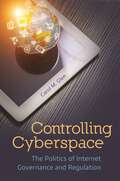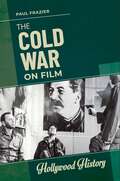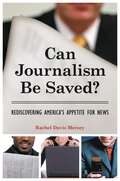- Table View
- List View
Navigating an Organizational Crisis: When Leadership Matters Most
by Harry Hutson Martha JohnsonHow are leaders facing a crisis supposed to handle and overcome an unknowable set of issues? This book demonstrates how effective leaders under pressure work from an understanding of the situation at hand and of their impact on others, and explains how leaders can best apply their internal strengths.Most leaders are steeped in risk management, crisis response tactics, readiness for disaster, continuity-of-operations planning, and logistical and agility capabilities. These preparations are critical but not complete. The reality is that even experienced leaders themselves need guidance when it comes to managing a crisis. This standout book fills that need, drawing on interviews with successful leaders; research findings on trauma, neuroscience, and crisis management; and the authors' own extensive career experiences. The chapters suggest and probe ideas from various angles rather than promoting simplistic formulas or nostrums that are unlikely to apply to all circumstances and present new angles on self-awareness and management under pressure for the practitioner.The book leads off with a description of organizational disaster and crisis leadership—topics of considerable concern as disasters are becoming the "new normal." The authors then explore three critical but very different types of responses by leaders at such a time: recognition and response, care of self and others, and storytelling. A detailed case study of a leader in the midst of Hurricane Katrina—the most expensive natural disaster in U.S. history—provides readers with a real-world practicum for the theories and ideas suggested.
Models of Proposal Planning & Writing
by Jeremy T. Miner Kelly C. Ball-StahlThis book is an essential weapon for anyone looking for funding in the extremely competitive grantseeking world. It explains how and why to approach both public and private sponsors with not just information, but persuasion, for the best chance for success.How do you present the right balance of logic, emotion, and relationship-awareness to make a persuasive proposal? What is THE most important thing to do before submitting a proposal to increase your odds for funding success? What portion of the proposal must be stressed even when it has a low point value assigned to it in the reviewer's evaluation form? How can a site visit make or break the fate of a meticulously prepared application? Models of Proposal Planning & Writing: Second Edition answers all these critical questions and more for grantseekers, documenting how to write a proposal that will persuade a sponsor to invest in your projects and organization—and just as importantly, explaining why a properly persuasive application puts forth a seamless argument that stands the test of reason, addresses psychological concerns, and connects your project to the values of the sponsor. The book's comprehensive annotations provide practical information that walks readers step-by-step through a logical, integrated process of planning and writing persuasive proposals.
Living on Automatic: How Emotional Conditioning Shapes Our Lives and Relationships
by Homer B. MD Christine B. MDTwo veteran psychiatrists unravel the mystery of how thought and emotional patterns are passed from parents to children, generation after generation, "conditioning" each of us in ways that endure throughout our lives and affect all of our relationships.Living on Automatic not only introduces the concept of emotional conditioning, including how it occurs and becomes entrenched in our minds, but also explains how individuals can "decondition" themselves to become more adept at choosing and negotiating more rewarding relationships. Authored by two psychiatrists, the text draws from more than 80 years of their combined psychotherapy work with thousands of people. The authors focus on helping readers to understand their roles in relationships and to develop more rewarding relationships. Case studies and questions are provided to illustrate emotional conditioning and the personality roles that emerge from it. Readers will learn why people choose the mates that they do; why the ways we learn to relate as children often do not change later in life; and how to observe and engage in introspection to begin to decondition themselves from auto-pilot, knee-jerk emotional responses, allowing for the formation of better relationships with their spouse or partner, children, and other family members.
The Limits of the Digital Revolution: How Mass Media Culture Endures in a Social Media World
by Derek HrynyshynThis academic analysis explores social media, specifically examining its influence on the cultural, political, and economic organization of our society and the role capitalism plays within its domain.In this examination of society and technology, author and educator Derek Hrynyshyn explores the ways in which social media shapes popular culture and how social power is expressed within it. He debunks the misperception of the medium as a social equalizer—a theory drawn from the fact that content is created by its users—and compares it to mass media, identifying the capitalist-driven mechanisms that drive both social media and mass media. The work captures his assessment that social media legitimizes the inequities among the social classes rather than challenging them.The book scrutinizes the difference between social media and mass media, the relationship between technologies and social change, and the role of popular culture in the structure of political and economic power. A careful look at social media networks such as Facebook, Twitter, and Google suggests that these tools are systems of surveillance, monitoring everyday activities for the benefit of advertisers and the networks themselves. Topics covered within the book's 10 detailed chapters include privacy online, freedom of expression, piracy, the digital divide, fragmentation, and social cohesion.
Libraries Publish: How to Start a Magazine, Small Press, Blog, and More
by Stephanie KatzIn this book, author Stephanie Katz, founding editor of the award-winning literary journal 805 Lit + Art, shares practical tools and advice for starting successful creative publishing projects.Publishing benefits libraries by providing high-quality content to patrons, showcasing local writers and faculty, and creating buzz for the library. These endeavors can be launched at any type and size of library, often for little to no cost. Libraries Publish teaches libraries how to publish literary magazines, book review blogs, local anthologies, picture books, library professional journals, and even novels. You'll learn how to run a writing contest or writer-in-residence program, form community partnerships with other literary organizations, find funding, navigate legal considerations, market your publication, and more. Each chapter contains detailed information on how to start your project, including comprehensive checklists, recommendations for free software, and legal considerations. Social media strategies as well as tips for facilitating student or teen-run projects are also covered. If your library wants to start a publishing project, this book will be your go-to resource!
Introduction to Cybercrime: Computer Crimes, Laws, and Policing in the 21st Century (Praeger Security International Textbook)
by Joshua B. Hill Nancy E. MarionExplaining cybercrime in a highly networked world, this book provides a comprehensive yet accessible summary of the history, modern developments, and efforts to combat cybercrime in various forms at all levels of government—international, national, state, and local.As the exponential growth of the Internet has made the exchange and storage of information quick and inexpensive, the incidence of cyber-enabled criminal activity—from copyright infringement to phishing to online pornography—has also exploded. These crimes, both old and new, are posing challenges for law enforcement and legislators alike. What efforts—if any—could deter cybercrime in the highly networked and extremely fast-moving modern world? Introduction to Cybercrime: Computer Crimes, Laws, and Policing in the 21st Century seeks to address this tough question and enables readers to better contextualize the place of cybercrime in the current landscape.This textbook documents how a significant side effect of the positive growth of technology has been a proliferation of computer-facilitated crime, explaining how computers have become the preferred tools used to commit crimes, both domestically and internationally, and have the potential to seriously harm people and property alike. The chapters discuss different types of cybercrimes—including new offenses unique to the Internet—and their widespread impacts. Readers will learn about the governmental responses worldwide that attempt to alleviate or prevent cybercrimes and gain a solid understanding of the issues surrounding cybercrime in today's society as well as the long- and short-term impacts of cybercrime.
The Inside Stories of Modern Political Scandals: How Investigative Reporters Have Changed the Course of American History
by Woody KleinThis book examines ten major political scandals involving the White House in the past 50 years, revealing how the investigative reporters behind the stories uncovered the hidden truths.On numerous occasions, the dogged efforts of investigative journalists have led to a dissemination of information that had a direct effect on the course of American history—the Bay of Pigs fiasco, the Watergate scandal, "Monicagate" of the Clinton administration, and the Enron accounting scandal.The Inside Stories of Modern Political Scandals: How Investigative Reporters Have Changed the Course of American History features in-depth interviews with all living journalists responsible for revealing major political scandals involving the White House, including Bob Woodward and Carl Bernstein, the reporters responsible for bringing the Watergate scandal to the light of day. The author presents a fascinating view into the "story behind the story" regarding the ten most momentous, modern-day political scandals in America. Containing both anecdotes from the investigative reporters involved and specific examples from published articles, this text reveals the specific methods used by these award-winning journalists to successfully pursue their stories and earn their titles as watchdogs of our government, our military, and big business.
Information Literacy and Libraries in the Age of Fake News
by Denise E. Agosto, EditorGoing beyond the fake news problem, this book tackles the broader issue of teaching library users of all types how to become more critical consumers and sharers of information.As a public, school, or academic librarian or educator, you can help library users to become more conscious and responsible consumers of information. As you read, you'll gain a better understanding and appreciation of the core concepts involved in promoting critical information literacy, such as information ethics, media literacy, and civic education. You'll also learn the history of fake news and come away with practical ideas in mind for strategies to apply in your library.Chapters contributed by leading experts in public, academic, and school library services are written in plain, everyday language that librarians and library school students can easily understand and relate to their own experiences as information users, especially their experiences in social media and other online venues where sharing false information takes only a click.
How to Write and Publish a Scientific Paper
by Barbara Gastel Robert A. DayThoroughly updated throughout, this classic, practical text on how to write and publish a scientific paper takes its own advice to be "as clear and simple as possible.""The purpose of scientific writing," according to Barbara Gastel and Robert A. Day, "is to communicate new scientific findings. Science is simply too important to be communicated in anything other than words of certain meaning."This clear, beautifully written, and often funny text is a must-have for anyone who needs to communicate scientific information, whether they're writing for a professor, other scientists, or the general public. The thoughtfully revised 9th edition retains the most important material-including preparing text and graphics, publishing papers and other types of writing, and plenty of information on writing style-while adding up-to-date advice on copyright, presenting online, identifying authors, creating visual abstracts, and writing in English as a non-native language.A set of valuable appendixes provide ready reference, including words and expressions to avoid, SI prefixes, a list of helpful websites, and a glossary. Students and working scientists will want to keep How to Write and Publish a Scientific Paper at their desks and refer to it at every stage of writing and publication.
How to Write about the Media Today (Writing Today)
by Raúl Damacio Tovares Alla V. TovaresA comprehensive and practical guide to writing a successful media paper or report, from selecting a topic to submitting the final draft.How to Write about the Media Today is the first book to offer students and media practitioners a comprehensive approach for researching and preparing a report, paper, or presentation on some aspect of today's mass communication. How to Write about the Media Today begins with a discussion of different types of media outlets—from traditional newspapers and television to the Internet—as well as an overview of contemporary directions in media studies. This is followed by a series of step-by-step strategies for selecting topics, conducting research, and writing cogently and engagingly about media-related events and issues. Because each chapter stands on its own, this resource can be read sequentially or consulted topic-by-topic as needed.
How to Design and Write Web Pages Today
by Karl StolleyThis unique guidebook lays the foundations of contemporary mobile-first, responsive web design, offering writers, designers, and those who teach them a complete and up-to-date approach to web design.Are you looking to learn web design the right way? Not by using an off-the-shelf software package, but by creating customized sites in a way that gives you full control? This guide provides that ability even if you have no previous coding skills or experience.One of the critical challenges of modern web design is being able to write for the mobile web to reach those increasingly mobile-connected users. How to Design and Write Web Pages Today addresses this key objective while also explaining how to deliver improved experiences for users of desktop-style devices based on the constraints and challenges of mobile design. This user-friendly tutorial begins with background information to enable a better understanding of the web and its purpose and function as well as how to generate material for a website. Readers then learn about the three overarching concerns in the short- and long-term viability and usefulness of websites: accessibility, usability, and sustainability. Key technologies and techniques for web design—such as the HTML and CSS languages to the conceptual foundations of grid-based design—are next, followed by a thorough explanation of how to publish a site on the open web, from creating a viable site architecture to automating the publishing of content to the open web.
How Racism and Sexism Killed Traditional Media: Why the Future of Journalism Depends on Women and People of Color (Racism in American Institutions)
by Joshunda SandersAn evaluative examination that challenges the media to rise above the systematic racism and sexism that persists across all channels, despite efforts to integrate.The Internet and social networks have opened up new avenues of communication for women and people of color, but the mainstream news is still not adequately including minority communities in the conversation. Part of the Racism in America series, How Racism and Sexism Killed the Traditional Media: Why the Future of Journalism Depends on Women and People of Color reveals the lack of diversity that persists in the communication industry. Uncovering and analyzing the racial bias in the media and in many newsrooms, this book reveals the lesser-known side of the media—newsrooms and outlets that are often fraught with underlying racist and sexist tension.Written by a veteran journalist of color, this title brings an insider's perspective combined with interviews from industry experts. The book analyzes the traditional media's efforts to integrate both women and people of color into legacy newsrooms, highlighting their defeats and minor successes. The author examines the future of women and people of color in the mainstream media.
Hatred of America's Presidents: Personal Attacks on the White House from Washington to Trump
by Lori Cox HanThis work examines expressions of personal hostility and animosity toward presidents—even beloved ones—throughout American history and their impact on policymaking, politics, and culture.People involved or simply interested in politics often ask whether today's political environment is more toxic than ever before. Hatred of America's Presidents: Personal Attacks on the White House from Washington to Trump presents an impartial and authoritative history of invective toward the White House so readers can determine the answer for themselves.The book focuses on the most representative and commonplace attacks of a vitriolic and personal nature, detailing who instigated and trafficked in the attacks and how presidents, administrations, and political parties defended themselves. It also illustrates how honest disagreements about policy—such as FDR's New Deal, Ronald Reagan's Central America policies, George W. Bush's invasion of Iraq, and Barack Obama's Affordable Care Act—fueled expressions of hatred and condemnation. Finally, the book includes perspectives from both the right and the left on the legitimacy of these attacks and the victims' defenses as well as their impact on American politics and policy.
Future-Ready Leadership: Strategies for the Fourth Industrial Revolution
by Chris R. GroscurthProvides executive leadership teams with information, tools, and advice they need to lead their organizations into the "future of work," characterized by transformative, smart, and connected technologies already under way, including artificial intelligence, the Internet of things, and automation.The technological and economic forces of the fourth industrial revolution (4IR) are shifting organizations in radical new directions. Automation is taking place not only in factories but in retail environments, and it is not just powerful or precise: it is intelligent, and it learns. Leaders must learn to rely on new sources of data, analytics, and intelligence in their efforts to anticipate emerging trends, forecast unforeseen consequences, make sense of systems and complexity, communicate constantly, build strong networks based on trust, and ultimately, win a following.Future-Ready Leadership is an invaluable resource for leaders and leadership educators seeking to transform 4IR trends into a source of collaborative (as opposed to competitive) advantage. A blueprint for reshaping the future of work, the book meets readers' "awareness need" by exploring cutting-edge research on technology's impact on the workplace. Each chapter uses data to set up a specific future of work leadership challenge, offering readers practical solutions and advice, actionable recommendations, and tools for reflection and action that can be put into practice right away.
From Twitter to Tahrir Square [2 volumes]: Ethics in Social and New Media Communication [2 volumes]
by Bala A. Musa and Jim WillisThis timely guide examines the influence of social media in private, public, and professional settings, particularly the ethical implications of the cultural changes and trends created by their use.In the quest for quick dissemination of information, web users and content providers find both opportunity and liability in digital broadcasts. Examples abound: Twitter members tap into news reports well in advance of traditional print media, but stories are prone to inaccuracies and misinformation; Facebook shares useful data mined from member profiles, but this sharing often compromises privacy. It is no surprise that use of social media gives rise to a host of moral dilemmas never before encountered. This book sheds light on the effects of this new medium on the individual and society.Through two volumes chock full of topics found in news headlines everyday, the authors look at evolving trends in social media and their impact on privacy, politics, and journalism. The first volume explores the role of this technology on national and international security. Volume 2 focuses on the individual as both a producer and consumer of internet content, showing how the media itself is changing notions of self-identity, relationships, and popular culture. The book's content covers such topics as individual and community psychology, citizen journalism, and corporate technology.
Free Speech and Censorship: A Documentary and Reference Guide (Documentary and Reference Guides)
by Cari Lee EastmanThis annotated document collection surveys the history and evolution of laws and attitudes regarding free speech and censorship in the United States, with a special emphasis on contemporary events and controversies related to the First Amendment.The United States' collective understanding of First Amendment freedoms was formed by more than 200 years of tensions between the power of word and the power of the government. During that time, major laws and legal decisions defined the circumstances and degree to which personal expression could be rightfully expressed—and rightfully limited.This struggle to define the parameters of free speech continues today. Vibrant and passionate debates about First Amendment limitations once inspired by the dissemination of birth control information now address such issues as kneeling during the national anthem, removing controversial books from public libraries, attempts by the Trump administration to discredit the press, and disseminating false or hateful information through social media platforms. By exploring diverse examples of censorship victories and triumphs of free expression, readers will better understand the enormous impact of First Amendment freedoms on American society.
Examining Internet and Technology around the World (Global Viewpoints)
by Laura M. SteckmanThis book offers comparative insights into the challenges and opportunities surrounding emerging technology and the internet as it is used and perceived throughout the world, providing students with cross-cultural and cross-national perspectives.The United Arab Emirates has a national goal of colonizing Mars by 2117, and China seeks to modernize its entire manufacturing process to produce cutting-edge technologies and research advances by 2025. How are other countries using the internet and emerging technologies to their advantage? This volume in the Global Viewpoints series examines 10 issues pertaining to the internet and technology, including access and censorship, alternative energy technologies, artificial intelligence, autonomous robots, cyberbullying, cybercrime, e-learning, GMOs, online privacy, and virtual and augmented reality. For each topic, the volume features eight country-level perspectives that span the world to allow for comparisons of different nations' specific approaches to the technology or issue. This encyclopedia takes a new direction in understanding the importance and impact of emerging technologies on the world, showing that even when experiencing similar technologically related challenges or advances, these technologies do not form one-size-fits-all solutions for every nation and population. Even when nations develop similar technologies, human dimensions—from policy to social norms to culture—influence people and society across the world differently.
Distracted: Staying Connected without Losing Focus
by Terri R. Kurtzberg Jennifer L. GibbsWhat are the benefits and negative consequences of our increased connectivity at school, at work, and at home? Is being constantly distracted now a worldwide problem? This book examines how new technologies and social pressures have changed the way we use our attention, and the extent to which they drive us to distraction, by interpreting hundreds of scientific studies from the literatures in cognitive and social psychology, sociology, communication, management, and decision making.While distraction is ever-present in daily life, staying connected in an efficient way is the goal for one and all. To accomplish that, some amount of fine-tuning of typical interactions with technology is in order. Nearly everyone recognizes the addictive nature of constant connectivity—and its destructive effect on productivity and quality of work. But the availability of technology also promotes better engagement, control, and flexibility in both professional and personal settings. An in-depth analysis of these tradeoffs can lead to smarter choices about when and how to be connected throughout the day and across settings. The ultimate objective is to have technology enhance our lives without serving as a source of constant distraction.Distracted: Staying Connected without Losing Focus explains the nuances of what this addiction stems from—considering both societal and technological factors—and identifies both the invaluable opportunities and the counterproductive consequences of living in our technology-enabled, instant-access-to-everything world. The chapters examine a wide swath of scientific research to expose how technology use affects our attention and the extent to which it causes distraction. Authors Terri Kurtzberg and Jennifer Gibbs apply the science of human attention to reveal how specific areas of our lives are significantly changed with the advent of "continuous connectedness," including in the workplace, in personal relationships, in childhood development, and with regard to education and learning. Readers will clearly understand why multitasking fails us, what the consequences are—to ourselves and those around us—of being focused on a screen for much of the day, and how each of us can adjust our use of technology in order to improve our lives.
The Disposable Visionary: A Survival Guide for Change Agents
by Curtis Powell Bill . JeromeIs it possible for visionary leaders to adhere to their idealism and integrity without becoming casualties of corporate conservatism and executive-level politics? This book says "yes," arguing for the need for visionary change agents in organizations and resolving the paradox of visionary change in a bureaucratic environment.Why do many companies state they want change but then often fire employees who truly rock the boat in their efforts to shift the paradigm to make improvements? How should "disposable visionaries"—leaders who are passionate about new ideas, but who underestimate or intentionally ignore the political environment that supports maintaining the status quo and consequently are in danger of losing their jobs—keep their passion regardless of the opposition… and also keep their jobs?Written with wit and filled with poignant insights and well-documented examples, this book provides practical advice and encouragement to those who are driven to promote new ideas and reach new levels of achievement. Not just for executive-level corporate leaders frustrated by their company's resistance to change, the information and inspiration presented will be enlightening to anyone who has ever been puzzled or annoyed by obstructive internal politics at work. Readers will come away with effective ways to deal with politics, champion breakthrough innovation, be recognized as their organization's most valuable asset, and unlock their potential to change the competitive playing field. The book will also be invaluable for business students who need to be aware of potential obstacles they will likely face as they embark on their careers.
Digital Influence Warfare in the Age of Social Media (Praeger Security International)
by James J. ForestThis timely book spotlights how various entities are using the Internet to shape people's perceptions and decision-making. It also describes detailed case studies as well as the tools and methods used to identify automated, fake accounts.This book brings together three important dimensions of our everyday lives. First is digital-the online ecosystem of information providers and tools, from websites, blogs, discussion forums, and targeted email campaigns to social media, video streaming, and virtual reality. Second, influence-the most effective ways people can be persuaded, in order to shape their beliefs in ways that lead them to embrace one set of beliefs and reject others. And finally, warfare-wars won by the information and disinformation providers who are able to influence behavior in ways they find beneficial to their political, social, and other goals.The book provides a wide range of specific examples that illustrate the ways people are being targeted by digital influencers. There is much more to digital influence warfare than terrorist propaganda, "fake news," or Russian efforts to manipulate elections: chapters examine post-truth narratives, fabricated "alternate facts," and brainwashing and disinformation within the context of various political, scientific, security, and societal debates. The final chapters examine how new technical tools, critical thinking, and resilience can help thwart digital influence warfare efforts.
Debates for the Digital Age [2 volumes]: The Good, the Bad, and the Ugly of Our Online World [2 volumes]
by Danielle Sarver Coombs and Simon CollisterBy evaluating the Internet's impact on key cultural issues of the day, this book provides a comprehensive overview of the seismic technological and cultural shifts the Internet has created in contemporary society.Books about Internet culture usually focus on the people, places, sites, and memes that constitute the "cutting-edge" at the time the book is written. That approach, alas, renders such volumes quickly obsolete. This provocative work, on the other hand, focuses on overarching themes that will remain relevant for the long term. The insights it shares will highlight the tremendous impact of the Internet on modern civilization—and individual lives—well after specific players and sites have fallen out of favor.Content is presented in two volumes. The first emphasizes the positive impact of Internet culture—for example, 24-hour access to information, music, books, merchandise, employment opportunities, and even romance. The second discusses the Internet's darker consequences, such as a demand for instant news that often pushes journalists to prioritize being first over being right, online scams, and invasions of privacy that can affect anyone who banks, shops, pays bills, or posts online. Readers of the set will clearly understand how the Internet has revolutionized communications and redefined human interaction, coming away with a unique appreciation of the realities of today's digital world—for better and for worse.
The Critical Writer: Inquiry and the Writing Process
by Joyce Armstrong Carroll Edward E. WilsonHigh-quality original writing doesn't happen by accident; it results from a logical, inquiry-based process. Educators will be able to apply the concepts and techniques in this book to help their students master the critical writing process.Many students tremble at the mere thought of "the dreaded research paper" when in fact the inquiry process that should be applied for a writing project should be an engaging and exciting mental activity. This work explains how teachers and librarians can guide the critical writing process to go hand-in-hand with inquiry and produce logical and carefully honed papers.The Critical Writer: Inquiry and the Writing Process starts with a general treatment of inquiry to detailed coverage of specific teaching strategies, explaining how critical writers should make the proper emendations during prewriting and while drafting as well as during the revising process. The book presents fresh information and teaching techniques that can be applied by anyone in the field of education with students of any grade level; examples from kindergarten through instructors in teacher training are included.
Controlling Cyberspace: The Politics of Internet Governance and Regulation
by Carol M. GlenInformed by theories of international relations, this book assesses global political conflicts over cyberspace. It also analyzes the unique governance challenges that the Internet presents, both in terms of technical problems and control over content.The Internet is a resource of unparalleled importance to all countries and societies, but the current decentralized system of Internet governance is being challenged by some governments that seek to assert sovereign control over the technology. The political battles over governing the Internet—ones that are coming and conflicts that have already started—have far-reaching implications. This book analyzes the shifting nature of Internet governance as it affects timely and significant issues including Internet freedom, privacy, and security, as well as individual and corporate rights.Controlling Cyberspace: The Politics of Internet Governance and Regulation covers a broad range of issues related to Internet governance, presenting a technical description of how the Internet works, an overview of the Internet governance ecosystem from its earliest days to the present, an examination of the roles of the United Nations and other international and regional organizations in Internet governance, and a discussion of Internet governance in relation to specific national and international policies and debates. Readers will consider if access to the Internet is a human right and if the right to freedom of expression applies equally to the exchange of information online. The book also addresses how the digital divide between those in developed countries and the approximately 5 billion people who do not have access to the Internet access affects the issue of Internet governance, and it identifies the challenges involved in protecting online privacy in light of government and corporate control of information.
The Cold War on Film (Hollywood History)
by Paul FrazierThe Cold War on Film illustrates how to use film as a teaching tool. It stands on its own as an account of both the war and the major films that have depicted it.Memories of the Cold War have often been shaped by the popular films that depict it—for example, The Manchurian Candidate, The Hunt for Red October, and Charlie Wilson's War, among others. The Cold War on Film examines how the Cold War has been portrayed through a selection of 10 iconic films that represent it through dramatization and storytelling, as opposed to through documentary footage.The book includes an introduction to the war's history and a timeline of events. Each of the 10 chapters that follow focuses on a specific Cold War film. Chapters offer a uniquely detailed level of historical context for the films, weighing their depiction of events against the historical record and evaluating how well or how poorly those films reflected the truth and shaped public memory and discourse over the war. A comprehensive annotated bibliography of print and electronic sources aids students and teachers in further research.
Can Journalism Be Saved?: Rediscovering America's Appetite for News
by Rachel Davis MerseyThis book challenges the once-dominant social responsibility model and argues that a new, "individual-first" paradigm is what will allow journalism to survive in today's crowded media marketplace.By some measures, it would seem that print journalism is dying. Journalism recently suffered one of its worst circulation declines in years: a drop of more than ten percent in the a six month period ending September 30, 2009. The Rocky Mountain News in Denver, CO, closed its doors in 2009—after it dominated the AP awards in 2008, and was lauded for an investigative expose on unfair treatment of former nuclear workers. Even the New York Times and the Washington Post are experiencing financial trouble. But print advertising revenue still trumps online advertising revenue ten-fold. Is there hope yet for traditional journalism?This book reviews the complicated challenge facing journalism, tracing its 19th-century community-oriented origins and documenting the vast expansion of the news business via blogs and other Internet-enabled outlets, user-generated content, and news-like alternatives. The author argues that a radical shift in mindset—striving to meet each individual's demands for what he wants to know—will be necessary to save journalism.
